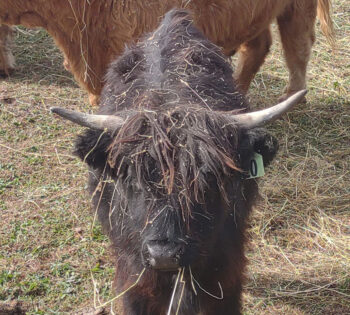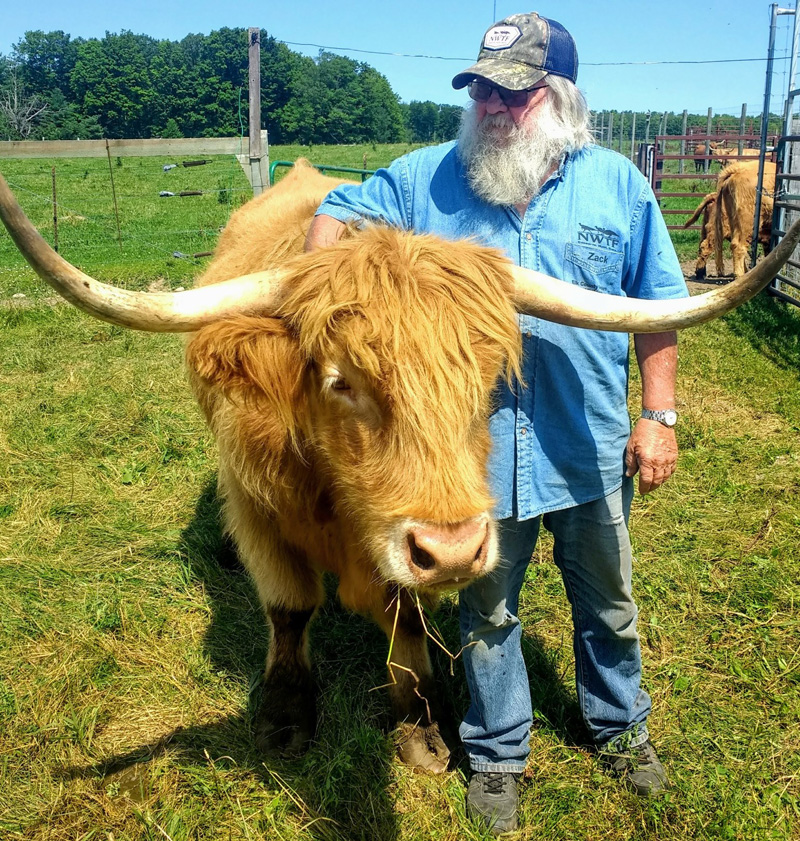By Kirk Rogers
It’s a beautiful early October day in Oscoda County.
Winds are calm. The sky is an uninterrupted blue. The maples splash the tree line with gradients of scarlet, yellow, and orange, while the sumacs adorn the tree’s ankles with fiery red stockings.
Autumn has finally tethered itself to this glacial soil. It is an idyllic setting. It is unburdened by hurry. It is undaunted by the shivering season to come.
Yet, there is unrest.
It has been a dry summer and the pastures are dusty. The cattle have had little more than stubble to graze on, so they await the appearance of Dale (Zak) Schrock on his New Holland blue.
If the hay arrives a bit late the cattle may bellow in frustration. Today there is no lowing, but as the tractor nears the pasture and Zak dismounts to open the gate, the herd, some 50 strong, begins lumbering toward the buffet.
These cattle are magnificent with arched horns stretching as far as four feet, tip to tip. While the bulls are larger in stature, all specimens have their signature horns and even the calves are born with skull buttons.
The coats they wear today are of the summer fashion line. However, when winter arrives, the fur will thicken enough to capably protect even the youngest herd members from not only the biting winds of Northern Michigan, but also the brutal Scottish Highlands’ climate, in which this hearty breed originated, and after which it is named.
Scottish Highland Cattle are among the most beloved of bovines for their shaggy coats, wide horns, and gentle dispositions. Zak isn’t afraid to walk among them, though he duly respects a young calf’s mother.
Zak’s herd is multicolored. On day one, however, it was a monochrome rust. A few years later he introduced a darker bull to add some variation. Thereafter a color or two arrived which had no obvious provenance.
Now he has cattle of colors and shades that are a complete mystery. “I’ve got no idea where that came from,” he says, referring to an adolescent blond bull.
They are endearing. The 1,100-pound bull that Zach bottle fed “has become a pain in my neck. He won’t leave me alone”. While Zac opines, one cannot help but wonder about the inconvenience of owning a lap bull.
That’s not to say that a specimen cannot have a dark heart. Zak once purchased a Highland bull and introduced it to the herd.
The next day it killed a bull. Two days later it killed a cow. That animal’s reign of terror lasted a week. Shortly thereafter Zak was once again established as King. (Details omitted for the faint hearted.)
In recent years these cattle have become more prevalent among ranchers and more popular with consumers as their meat is both tasty and low in cholesterol.
It wasn’t that long ago that Zak was raising another type of cattle on this farm that the Schrock family has owned and operated since 1955. American Bison were pastured here for several years before one animal tested positive for TB in the late 2000s.
While the meats of bison and Scottish Highland cattle are similar, their dispositions are decidedly unalike. The bison were much more territorial, nasty in temperament, and unpredictable. Zak stayed on his tractor when bison were near afoot.
“There was a time I was trying to load one into a trailer. I was nudging it up the ramp with the Ford tractor. It got mad, turned around, and came right over the front of the tractor. I wasn’t hurt because I bailed out.”
The bison have been gone for several years now and he’d consider bringing more in, but with the corrals now removed a reintroduction is unlikely. Now the farm is strictly inhabited by the Scots.
When Zak was quite young, this had been a dairy farm operated by John (Shorty) Schrock, his father. He grew up on 160 acres milking, haying, feeding and helping maintain the spread. “Dairy is why I left the farm. I wasn’t interested”.
A 39-year Consumers Energy career interrupted Zak’s farm life. After working strictly downstate for several years he was eventually able to transfer to a maintenance position on the hydroelectric dams along the AuSable River. Working near Fairview allowed Zak to juggle one career on the river, and another on the familiar dirt of his childhood.
Unfortunately, this has been a tough year on that dirt.

Rain has been plentiful in areas not too distant, but this year’s dry conditions produced one cutting of hay when in some years it nets three. As a result, the line of 750-pound bales is much shorter than normal, and with pasture foraging providing so little nourishment, Zak is once again in the field hauling a bale of mixed grasses.
To make sure that every diner gets enough, Zak suspends the bale a few feet off the ground. Soon many in the herd are munching either directly from the bale, from tufts of grass that have fallen to the ground, or from grass that landed on animals standing beneath the fallout. “It will all get eaten. They don’t waste anything.
Zak backs up the tractor several times so that different cattle of varying size can take turns covering themselves in fodder. Even the smaller horned and hoofed become satisfied.
When all are calmly munching away, Zak drops the remainder of the bale in a feeder where it will succumb to less desperate appetites.
The feeder sits in a spindly leaf that reminds us that there are no guarantees in any business that relies on a natural whim. Fruit trees fail. Diseases attack. Pests invade. Either drowned or parched turf, depending on the seed or the month, can devastate a crop.
Zak’s herd will be thinner this winter because of the rain clouds that parted over Oscoda County. His spread remains dry with grasses sun-bleached underfoot. As a result, there simply aren’t enough bales lining the fields to even hope to feed every mouth through spring.
“The trees are really beautiful right now”. Zak is perpetually good natured but lets out a sigh. “I just wish we’d had more rain”.


